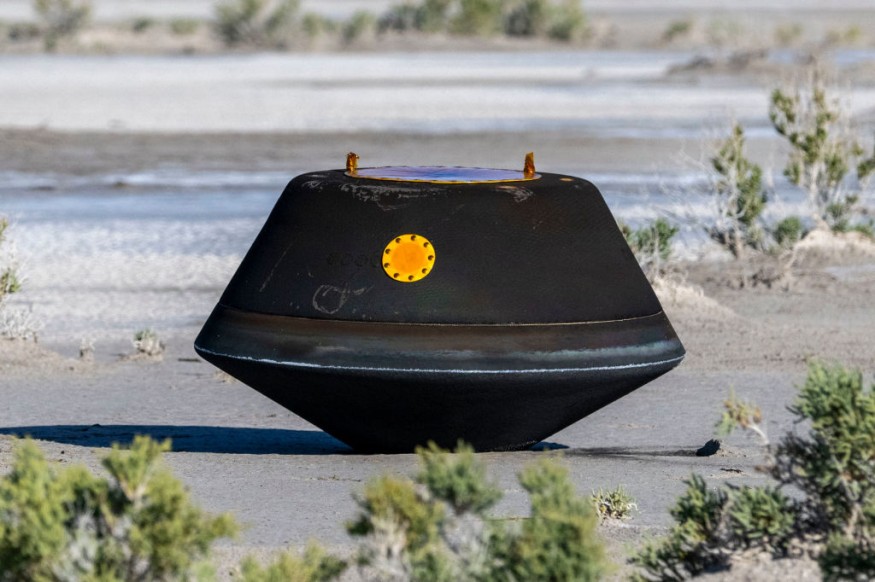A month ago, a capsule containing asteroid samples landed on Earth. However, NASA faces challenges opening it to access the space rocks. Despite this, preliminary analysis of samples outside the container suggests the material is rich in water and carbon, supporting the idea that asteroids like Bennu may have influenced life on Earth.

OSIRIS-REx Mission Deemed a Success
On September 24, NASA marked a momentous occasion as a charred orange-and-white capsule, bearing fragments of the asteroid Bennu, touched down on Earth after an ultra-high-speed entry through our atmosphere. Bennu, believed to have been a space wanderer since the early days of our solar system, promises to offer insights into the distant cosmic past.
The capsule embarked on its journey as part of NASA's OSIRIS-REx mission in 2016, encapsulating the precious asteroid material after an extraordinary 4-billion-mile trek. Employing an extending arm, it briefly made contact with Bennu's surface to collect a small portion of its material.
The initial aspiration was to secure a minimum of 60 grams of Bennu's material, a target that was remarkably surpassed when the OSIRIS-REx team revealed the successful retrieval of a considerably larger quantity.
Significantly, the curation team responsible for processing the samples, as per a NASA blog post, disclosed the extraction and collection of 70.3 grams (2.48 ounces) of Bennu material from the capsule, even before it was officially opened. These 70.3 grams encompass material from the external area and a section from inside the sample collector's head, accessed through the head's mylar flap.
Additionally, the post noted that a material residing within the sampler head, known as the Touch-and-Go Sample Acquisition Mechanism (TAGSAM), is slated for removal, further contributing to the total mass.
Despite these achievements, challenges have arisen in opening the container housing the majority of the samples within the TAGSAM. NASA stated that the OSIRIS-REx team encountered difficulties when trying to remove two of the 35 fasteners on the TAGSAM head using the approved tools in the OSIRIS-REx glovebox. In simpler terms, they are grappling with the task of accessing the primary sample contents.
NASA Plans To Share Bits of Asteroid Bennu With Other Researchers
Aside from OSIRIS-REx, there were also other asteroid-sample-return missions. JAXA's Hayabusa is the first one to collect samples from a space rock and it is noteworthy for delivering the largest-ever asteroid sample to Earth.
Like the Japanese space agency, NASA also plans to distribute bits of asteroid Bennu. The agency intends to allocate 25% of the Bennu samples to over 200 scientists at 25 different research facilities, 4% to the Canadian Space Agency, and 0.5% to JAXA, reciprocating a similar sharing arrangement when NASA received about 10% of the Hayabusa 1 asteroid payload from Itokawa.
The remaining 70% or so will be preserved at the Johnson Space Center for extensive study, akin to how Apollo moon rock samples continue to be a subject of research decades after being brought to Earth by astronauts.
The abundance of Bennu sample material in the capsule is partly due to the touch-and-go process itself. When the OSIRIS-REx's sample collection mechanism reached out to gather asteroid fragments, it was an unexpected revelation that Bennu wasn't a solid object as one might assume.
Instead, it exhibited a malleable nature. When the sample collection arm made contact with the asteroid, it released clouds of dust particles into the surroundings, causing a dramatic event and nearly engulfing the spacecraft.
This peculiar behavior also contributes to the uncertainty regarding the exact quantity of samples within the OSIRIS-REx capsule. The definitive amount will only be known once the container is opened. The team anticipates challenges in executing this task, as mentioned in the blog post.
RELATED ARTICLE:
Check out more news and information on OSIRIS-REx in Science Times.












